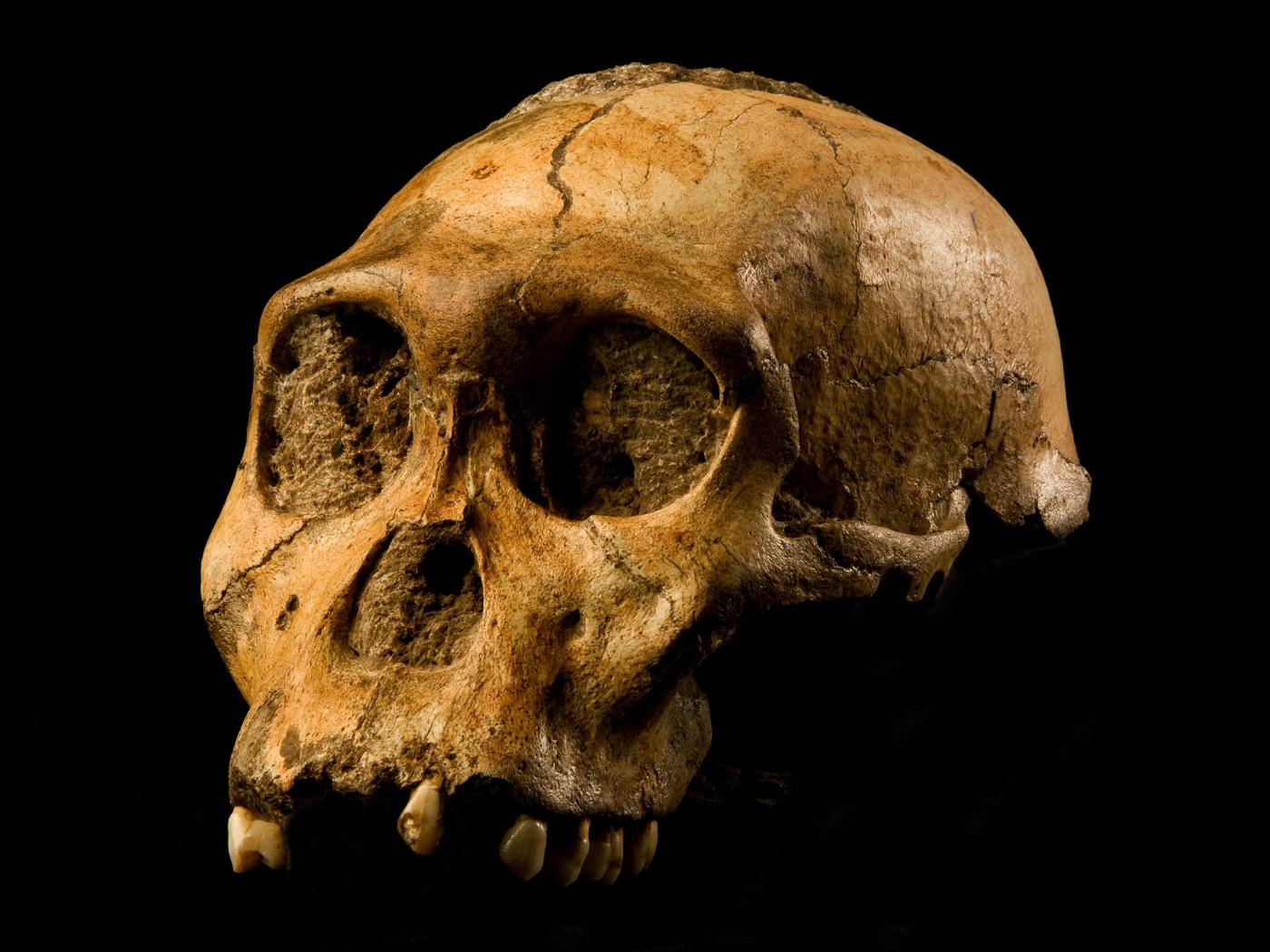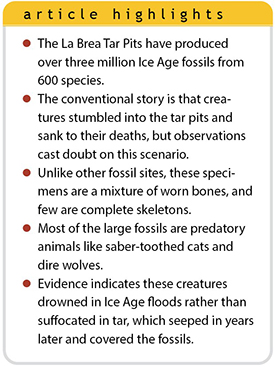 The La Brea Tar Pits have fascinated visitors ever since Spanish explorer Gaspar de Portolá chronicled the site in 1769.1 But even before that, humans had likely used the “tar” for several thousand years. Using land donated to the County of Los Angeles by George Allan Hancock in 1924, Hancock Park has produced over one million mammal fossils and one human skeleton from the tar pits near downtown Los Angeles.
The La Brea Tar Pits have fascinated visitors ever since Spanish explorer Gaspar de Portolá chronicled the site in 1769.1 But even before that, humans had likely used the “tar” for several thousand years. Using land donated to the County of Los Angeles by George Allan Hancock in 1924, Hancock Park has produced over one million mammal fossils and one human skeleton from the tar pits near downtown Los Angeles.
The oil for the tar comes from the Salt Lake oil field, about 1,000 feet below the park.1 Since oil is more buoyant than groundwater, it rises to the surface along fractures and faults near the crest of the oil field and then degrades over time. Bacterial action and surface evaporation remove the lightest components to leave a thick, sticky tar behind.
Tar-covered animal bones found in the nearly 100 pits include those from mammoths, mastodons, saber-toothed cats, dire wolves, sloths, camels, horses, smaller animals, insects, and even birds. Remains of plants and pollen have also been found. Overall, the bones come from 600 species. About 3.5 million specimens have been extracted from the pits over the last 100-plus years.2 The pits preserve a time capsule of animal and plant life that existed most likely near the end of the Ice Age.
The conventional story is that near the end of the last Ice Age, many animals got stuck in the tar over thousands of years. Their struggles attracted predators, and they, too, were trapped in the tar. Over time, they sank and became fossils. Animals today avoid such pits, casting doubt on that story. But observations at La Brea cause even more doubt.
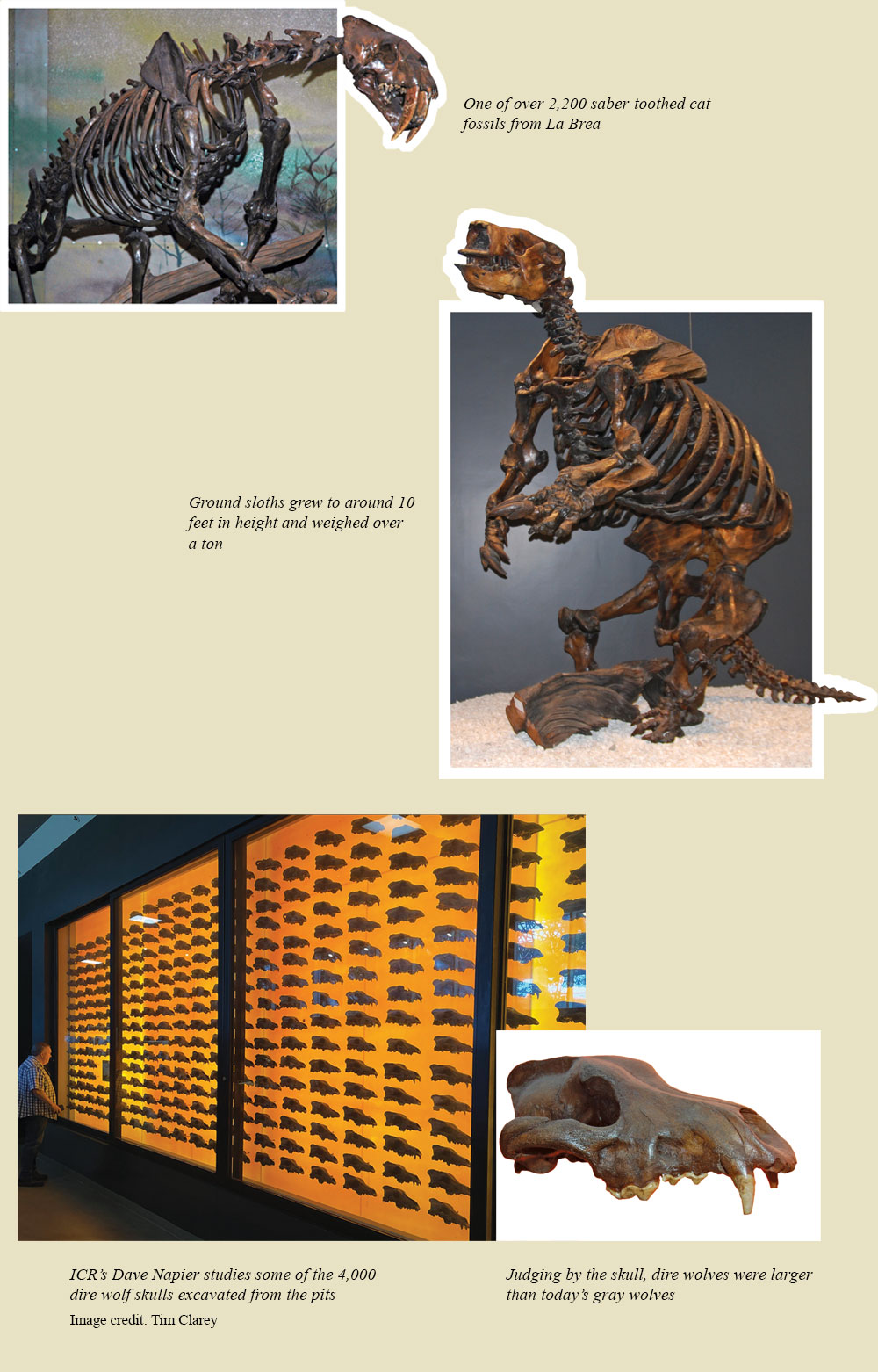

Four Unusual Observations
Four odd observations call for the popular story to be revised. First, very few articulated or complete specimens have been found.1 Instead, the bones are separated. Most are mixed with many other species and are jumbled in tight masses in the pits.
Individual specimens on display in Hancock Park are composed of bones from many different individuals, making “composite skeletons.” Some conventional scientists have suggested that bubbles of methane moving through the tar stirred up the bones. But how such gentle bubbles could so thoroughly dismember and mix these animals is a mystery to them. 1
Second, many of the bones show “pits and grooves” from bone rubbing against bone.1 This has been labeled “pit wear.” Exactly how the bones could rub against each other once embedded in sticky tar is also poorly explained.
A third observation is the overwhelming number of carnivore remains found in the pits compared to herbivores. About 4,000 dire wolves and 2,200 saber-toothed cats were excavated.1 Contrast that with 36 mammoths, 60 sloths, 220 horses, 300 bison, and 36 camels.1 Most of the bones were from predators, not prey!1 Conventional scientists claim this may be due to the biases of the early excavators who concentrated on the biggest bones. However, that claim is not a sufficient explanation because both the predators and prey have sizable bones.
Finally, the geology and paleontology of the site reflect massive flooding events. Excavators readily admit that some of the fossils were transported by moving water via stream channels and were deposited in the asphalt pits. A nearly complete adult Columbian mammoth named “Zed” was washed into the pits by stream flow where it became entombed in tar.1
There are also reports of four to eight feet of clay in some of the pits, with gravel and sand beds mixed in. These were most likely from river flow, consistent with regional flooding.3 Furthermore, test cores revealed four distinct layers of floodplain (river) deposits surrounding the pits. The cores showed weathered and rounded gravels plus the sand and clay that typify today’s river deposits.4 Even water-saturated plants have been excavated, including part of a cypress tree from Pit 3.3 These, too, indicate a waterborne origin at La Brea. How else could water later enter the oily tar pits and saturate the wood?
In spite of these four observations that cast doubt upon the tar entrapment theory, it is still generally accepted by the scientific community, and this is what the museum on site illustrates in its displays.
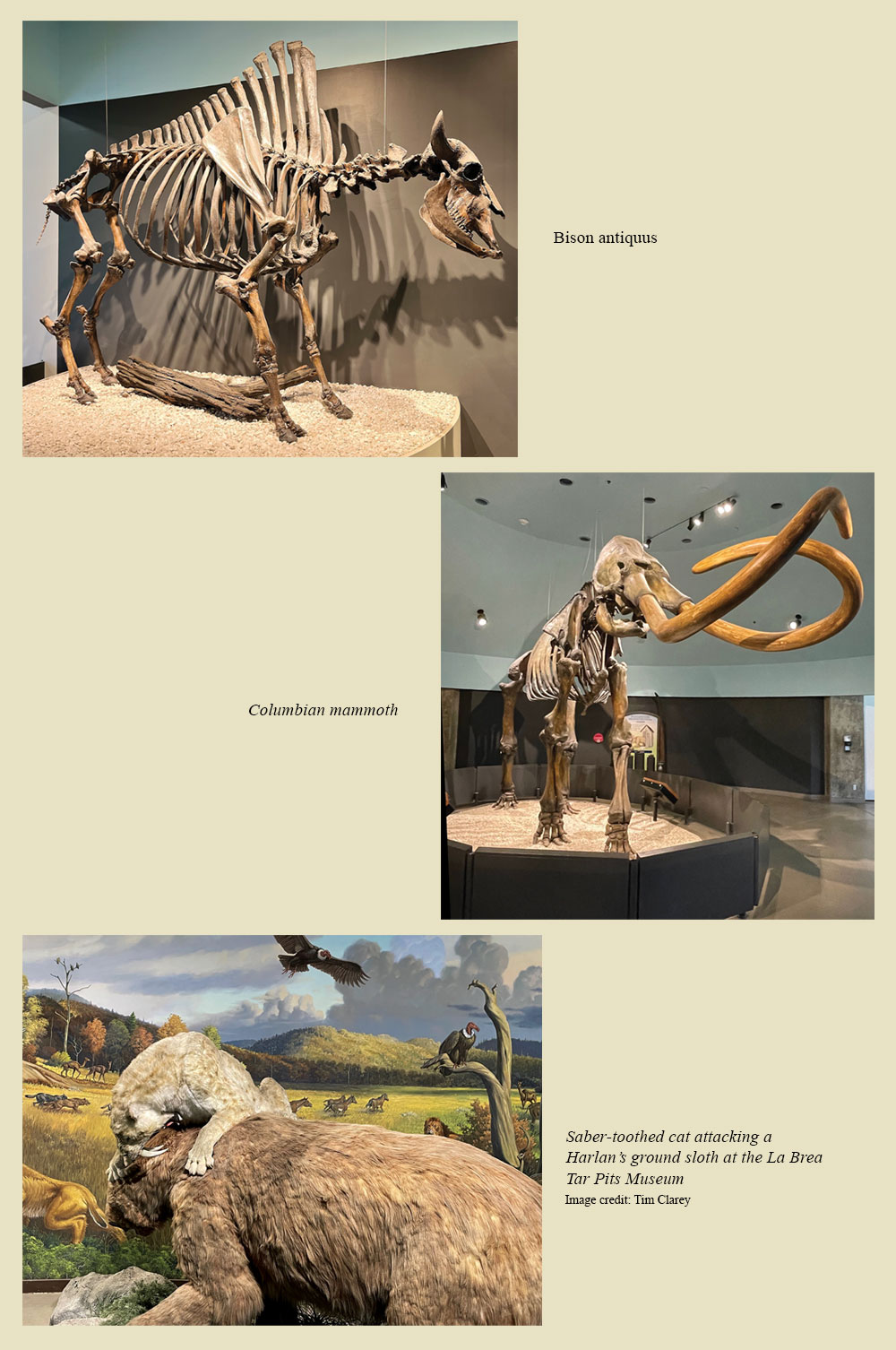

A Better Explanation
The conventional story of animals becoming trapped and slowly sinking in tar was initially questioned when the size of the pits and the size of the animals became known.4 Pit 36 had an opening of four feet by two feet and was only 11 feet deep, yet it contained six sizable carnivore fossils. The pits likely formed as methane gas associated with the oil collected in small, narrow openings resembling “blow-holes.”5
Some conventional and creationist scientists agree that water must have initially killed the animals rather than the tar itself. Water concentrated the fossils at the La Brea Tar Pits.6 Where could so much water come from after the Flood?
At the end of the Ice Age, rapid melting of nearby mountain ice and snow and heavy rains likely provided catastrophic water flow. This could have transported animal remains into the tar pit openings and deposited the bones in tight, jumbled masses. Such floods would likely have torn the animals apart and also caused the pits and grooves on the bones.
The entrapment theory only survives as myth, perpetuated by those not familiar with the geological evidence. It’s most likely that catastrophic rainfall and flooding during the late stages of the Ice Age provide a better explanation for the fossils at La Brea. And the Ice Age is best explained by the conditions created by the global Flood.7
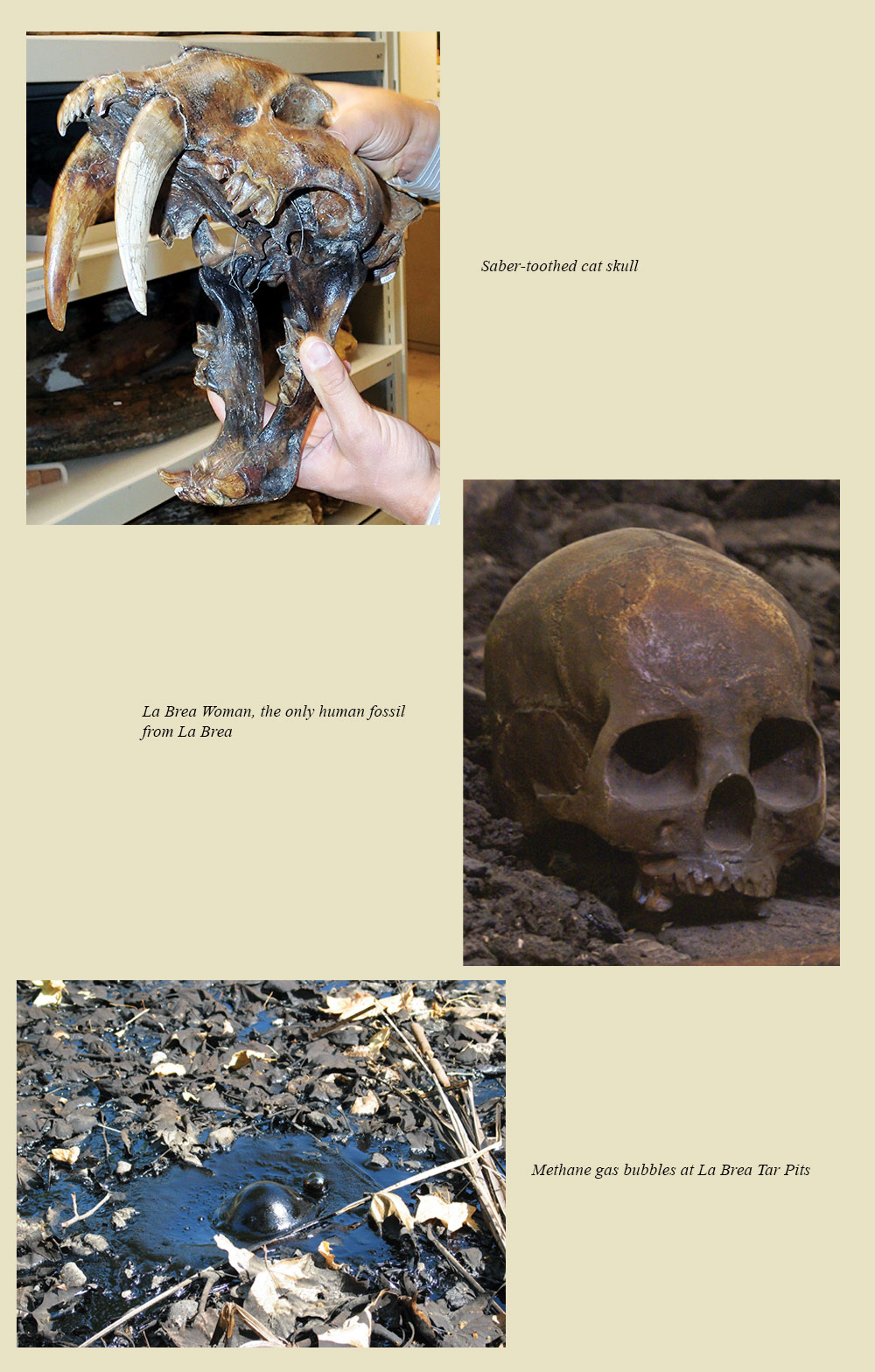

The Lone Human
A partial human skeleton, nicknamed La Brea Woman, was found in 1914. The fractured skull led some to speculate she was a victim of murder. One puzzle is why she’s even there at all.
In a 2022 Los Angeles Times article, La Brea Tar Pits and Museum Associate Curator and Excavation Site Director Emily Lindsey asked, “Humans were here, but why don’t we find any evidence of them at the La Brea Tar pits?” Maybe the people of that time had a healthy sense of self-preservation. The article goes on to say, “Lindsey notes that the absence of ancient humans could point to their reticence at hunting nearby saber-toothed cats and other dangerous animals.”8
Or perhaps the lack of human evidence is due to other factors entirely, such as humans not being caught in the water flows that washed the animal remains into what would become the tar pits. La Brea Woman’s presence at the pits could be a clue that people were avoiding this area by that point in the Ice Age, but the circumstances behind her ending up in Pit 10 will likely remain a mystery.
References
- Rancho La Brea: Treasures of the Tar Pits, 3rd ed., ed. Emily L. Lindsey (Los Angeles, CA: Los Angeles County Museum of Natural History Foundation, 2018).
- William Weston, “La Brea Tar Pits: Evidence of a Catastrophic Flood,” Creation Research Society Quarterly 40, no. 1 (2003): 25–33.
- William Weston, “La Brea Tar Pits: A Critique of Animal Entrapment Theories,” Creation Research Society Quarterly 39, no. 4 (2002): 160–167.
- Geoffrey D. Woodward and Leslie F. Marcus, “Rancho La Brea Fossil Deposits: A Re-evaluation From Stratigraphic and Geological Evidence,” Journal of Paleontology 47, no. 1 (1973): 54–68.
- John Morris and Timothy Clarey, “The La Brea Tar Pits Mystery,” Acts & Facts, June 2013, 14–15.
- Jeremy Auldaney, “Catastrophic Fluvial Deposition at the Asphalt Seeps of Rancho La Brea, California,” Proceedings of the International Conference on Creationism 3 (1994), 25–35.
- Jake Hebert, “The Bible Best Explains the Ice Age,” Acts & Facts, November 2018, 10–13.
-
Rachel Schnalzer, “The La Brea Tar Pits are full of mysteries. Here are three of the most puzzling,” Los Angeles Times, November 22, 2022, https://www.yahoo.com/ news/la-brea-tar-pits-full-150953540.htm
l.
* Dr. Clarey is the director of research at the Institute for Creation Research and earned his Ph.D. in geology from Western Michigan University




